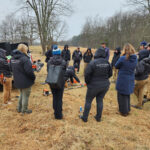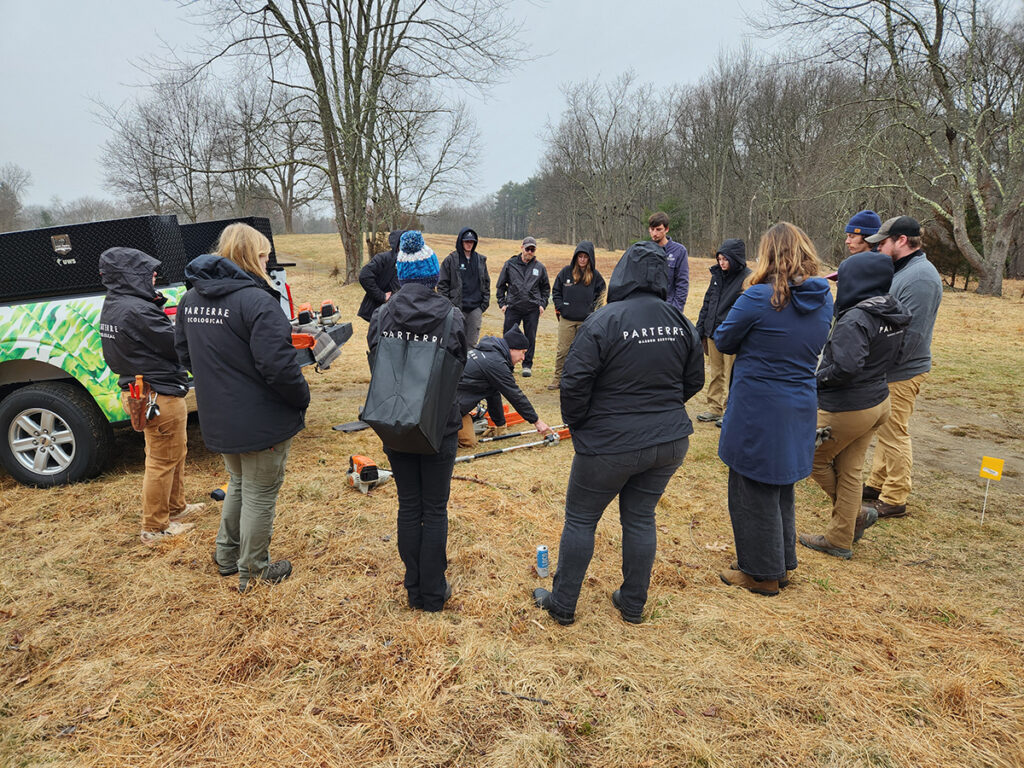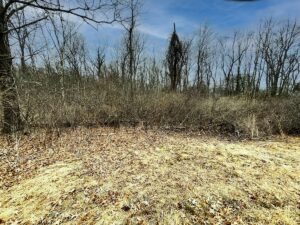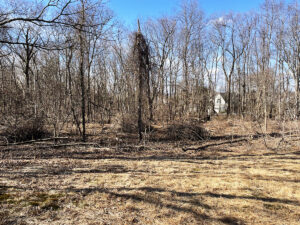
By Jeffrey North and Joseph Hibbard
A crew of 18 technicians, crew leaders, designer, and managers gathered on Lone Tree Hill early on the misty morning of March 15. They were there for the third and final day of their work season kick-off with a day of training on Belmont conservation land.
The Land Management Committee (LMC) for Lone Tree Hill (LTH) had granted permission to allow the Parterre Ecological Services “Class of 2024” to conduct an invasive species removal training session for field technicians. Their target zone was a section of the southeast corner of the Great Meadow. The training area offered a hands-on workspace for training in plant identification, hand cutting, safe chainsaw use, and stacking brush in habitat piles. Belmont resident and landscape architect Joseph Hibbard represented the LMC while working alongside Parterre staff.
The day included a review of the LTH land management plan, a talk about the site history, tool setup, instructions on debris piles (to provide housing for wildlife), herbicide signage, safety, seeding, and identification of invasive and native plants in the work area. The group received training and reinforcement of prior lessons in the step-by-step techniques of removing and treating invasive plants (cutting, dabbing, girdling, and spraying).
The result? This training exercise on LTH has produced a more capable group of field technicians, and another area of LTH has been cleared of invasive plant species, pro bono. Parterre work groups will return to LTH at intervals during the growing season to continue the ecological restoration work that began in 2020.
During orientation and training, the team completed an initial removal operation of invasive plants in one of the high-priority areas. They removed or cut back common buckthorn, glossy buckthorn, winged euonymus (burning bush), bittersweet, and honeysuckle. Visitors to the site can see the large brush piles stacked nearby.
After the Parterre team had cleared the buckthorn, bittersweet, burning bush, and honeysuckle, a stand of quaking aspen (poplar), Populus tremuloides, came newly into view.
Quaking aspen is probably North America’s most widely distributed tree. Its range extends from Alaska to Mexico and eastward across Canada and the northern United States to Newfoundland. Populus is also one of the most important genera serving as host plants for a wide range of caterpillars, a principal summer food source for migratory songbirds. According to a 2009 study by Douglas W. Tallamy, poplars host 367 species of caterpillars. Only four other genera of trees (oaks, willows, cherry, and birch) are more important than poplars as potential caterpillar host plants.
An aspen grove has been badly damaged by Asiatic bittersweet, a vine that can climb to the tops of trees and outcompete the aspen for sunlight. Aspen is exceedingly intolerant of shading, so it will perish if not rescued from the invader. As the bittersweet vine has covered the Lone Tree Hill aspen canopy, many trees have already been shaded to death by the vines.
Clearing the invasive species has now freed the aspen grove from foreign competition, allowing these aspen trees to prosper. This reference aspen grove is located at the top of the field, just below Mill Street, about 100 yards north of the main drive to the Rock Meadow parking lot. This majestic stand of aspen is what our LTH aspen grove will look like after its recuperation!
Other native trees in the area include hickory, oaks, gray birch, white birch, and a mature stand of sassafras, Sassafras albidum, a native woodland border tree with spectacular red fall color. Along with sugar maple and black tupelo trees, sassafras probably has the best fall color of our native trees.This stand is unique at LTH.
Future Restoration Plan Work for 2024
Volunteers will complete the clearing the area.
Parterre will apply herbicide to resprouting invasive plants in late summer or fall of 2024. The Judy Record Conservation Fund agreed to fund half of the cost of Parterre’s services.
Some new evergreen plantings may be included in proposals for revegetating the area outside the aspen grove. This initiative could be a natural continuation of the 2024 evergreen plantings planted during BCF volunteer days this spring.
The plan for 2025 is to continue removing invasive species from the rest of B5 along the southern border of the meadow.
The Belmont Citizens Forum and the Land Management Committee for Lone Tree Hill are deeply grateful for the ongoing support from the Judy Record Conservation Fund.
Jeffrey North is the managing editor for the Belmont Citizens Forum Newsletter. Joseph Hibbard is a landscape architect and Belmont resident.





Sorry, the comment form is closed at this time.